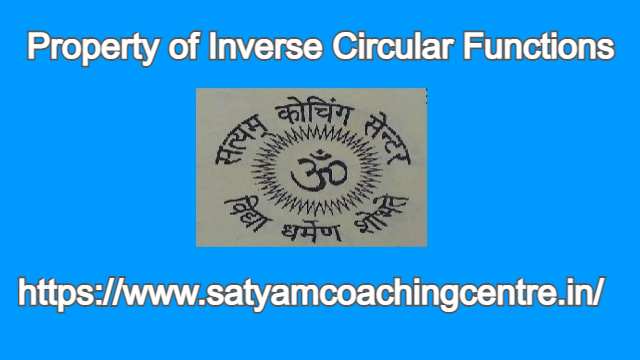Property of Inverse Circular Functions
1.प्रतिलोम वृत्तीय फलनों के गुणधर्म (Property of Inverse Circular Functions),प्रतिलोम त्रिकोणमितीय फ़ंक्शन के गुणधर्म (Properties of inverse trigonometric functions)-
- प्रतिलोम वृत्तीय फलनों के गुणधर्म (Property of Inverse Circular Functions) में प्रतिलोम वृत्तीय फलन को जानना आवश्यक है।हम जानते हैं कि \sin { \theta } ,\cos { \theta } ,\tan { \theta } इत्यादि त्रिकोणमितीय वृत्तीय फलन (Trigonometrical Circular Function) कहलाते हैं जिनमें से प्रत्येक,\theta के प्रत्येक मान के लिए एक निश्चित संख्या के बराबर होता है।यदि \sin { \theta } =x तो \theta =\sin ^{ -1 }{ x } होगा।
- कोण \theta को के रूप में व्यक्त करनेवाला व्यंजक प्रतिलोम वृत्तीय फलन (Inverse Circular Function) कहलाता है।इसी प्रकार कोण \theta को,एक संख्या x के रूप में व्यक्त करनेवाला अन्य प्रतिलोम वृत्तीय फलन है:
\cos ^{ -1 }{ x } ,\tan ^{ -1 }{ x } ,\sec ^{ -1 }{ x } ,\cot ^{ -1 }{ x } तथा { cosec }^{ -1 }x - \sin ^{ -1 }{ x } ,\cos ^{ -1 }{ x } फलनों में -1 घात नहीं है,इसे केवल प्रतिलोम फलन के संकेत के रूप में प्रयोग किया गया है क्योंकि { \left( \sin { x } \right) }^{ -1 }=\frac { 1 }{ \sin { x } } अतः \sin ^{ -1 }{ x } \neq { \left( \sin { x } \right) }^{ -1 }
- \sin ^{ -1 }{ x } एक कोण को व्यक्त करता है जबकि \sin { \theta } एक संख्या को जहां \theta एक कोण है।
- प्रतिलोम वृत्तीय फलन (Trigonometrical Circular Function)-
किसी फलन f का प्रतिलोम फलन { f }^{ -1 } ज्ञात करने के लिए फलन f ज्ञात करने के लिए f का एकैकी आच्छादक होना आवश्यक है। - वृत्तीय फलनों के अध्ययन से स्पष्ट है कि ये फलन अपने स्वाभाविक (सामान्य) प्रांत और परिसर में एकैकी और आच्छादक नहीं होते हैं।अतः इनके प्रतिलोम सामान्य स्थितियों में ज्ञात करना संभव नहीं होता है परन्तु इन फलनों के प्रांत को परिसीमित (प्रतिबंधित) करने पर ये फलन एकैकी आच्छादक हो जाते हैं तथा इन स्थितियों में इनके प्रतिलोम फलन ज्ञात किए जा सकते हैं।
- आपको यह जानकारी रोचक व ज्ञानवर्धक लगे तो अपने मित्रों के साथ इस गणित के आर्टिकल को शेयर करें।यदि आप इस वेबसाइट पर पहली बार आए हैं तो वेबसाइट को फॉलो करें और ईमेल सब्सक्रिप्शन को भी फॉलो करें।जिससे नए आर्टिकल का नोटिफिकेशन आपको मिल सके ।यदि आर्टिकल पसन्द आए तो अपने मित्रों के साथ शेयर और लाईक करें जिससे वे भी लाभ उठाए ।आपकी कोई समस्या हो या कोई सुझाव देना चाहते हैं तो कमेंट करके बताएं। इस आर्टिकल को पूरा पढ़ें।
Also Read This Article:-General Term of Geometric Progression
2.प्रतिलोम वृत्तीय फलनों के मध्य सम्बन्ध (Relation between Inverse Circular Functions)-
- मान लो \theta =\sin ^{ -1 }{ x } तो \sin { \theta } =x तब \cos { \theta } =\sqrt { 1-{ x }^{ 2 } } \\ \left( \because \sin ^{ 2 }{ \theta } +\cos ^{ 2 }{ \theta } =1 \right) \\ \theta =\cos ^{ -1 }{ \sqrt { 1-{ x }^{ 2 } } }
- इसी प्रकार \tan { \theta } =\frac { \sin { \theta } }{ \cos { \theta } } =\frac { x }{ \sqrt { 1-{ x }^{ 2 } } } \\ \Rightarrow \theta =\tan ^{ -1 }{ \left( \frac { x }{ \sqrt { 1-{ x }^{ 2 } } } \right) } \\ \cot { \theta } =\frac { \cos { \theta } }{ \sin { \theta } } =\frac { \sqrt { 1-{ x }^{ 2 } } }{ x } \\ \Rightarrow \theta =\cot ^{ -1 }{ \left( \frac { x }{ \sqrt { 1-{ x }^{ 2 } } } \right) } \\ \sec { \theta } =\frac { 1 }{ \cos { \theta } } =\frac { 1 }{ \sqrt { 1-{ x }^{ 2 } } } \\ \Rightarrow \theta =\sec ^{ -1 }{ \left( \frac { 1 }{ \sqrt { 1-{ x }^{ 2 } } } \right) } \\ cosec\theta =\frac { 1 }{ \sin { \theta } } =\frac { 1 }{ x } \\ \Rightarrow \theta ={ cosec }^{ -1 }\left( \frac { 1 }{ x } \right) \\ \therefore \sin ^{ -1 }{ x } =\cos ^{ -1 }{ \sqrt { 1-{ x }^{ 2 } } } =\tan ^{ -1 }{ \left( \frac { x }{ \sqrt { 1-{ x }^{ 2 } } } \right) } =\cot ^{ -1 }{ \left( \frac { x }{ \sqrt { 1-{ x }^{ 2 } } } \right) } =\sec ^{ -1 }{ \left( \frac { 1 }{ \sqrt { 1-{ x }^{ 2 } } } \right) } ={ cosec }^{ -1 }\left( \frac { 1 }{ x } \right)
3.प्रतिलोम वृत्तीय फलनों के गुणधर्म (Properties of Inverse Circular Functions),प्रतिलोम फलनों के गुणधर्म क्या हैं? (What are the properties of inverse functions?),प्रतिलोम त्रिकोणमितीय फलनों के गुणधर्म कक्षा 12 (Properties of inverse trigonometric functions class 12),प्रतिलोम त्रिकोणमितीय फलनों के प्राथमिक गुणधर्म कक्षा 12 (Elementary properties of inverse trigonometric functions class 12th)-
- (1.) \sin { \left( \sin ^{ -1 }{ x } \right) } =x,-1\le x\le 1 एवं \sin { \left( \sin ^{ -1 }{ \theta } \right) } =\theta ,-\frac { \pi }{ 2 } \le x\le \frac { \pi }{ 2 }
प्रमाण (Proof): \sin ^{ -1 }{ x } =\theta तब \sin { \theta } =x
\theta का मान पुनः रखने पर \sin { \left( \sin ^{ -1 }{ x } \right) } =x
पुनः यदि \sin { \theta } =x,-1\le x\le 1
तब \theta =\sin ^{ -1 }{ x } ,-\frac { \pi }{ 2 } \le x\le \frac { \pi }{ 2 } या \theta =\sin { \left( \sin ^{ -1 }{ \theta } \right) } - इस प्रकार दी गई सारणी के अनुसार x तथा \theta के अन्तरालों के लिए
\cos { \left( \cos ^{ -1 }{ x } \right) } =x\qquad \cos ^{ -1 }{ (\cos { \theta } ) } =\theta \\ \tan { \left( \tan ^{ -1 }{ x } \right) } =x\quad \quad \quad \tan ^{ -1 }{ (\tan { \theta } ) } =\theta \\ \cot { \left( \cot ^{ -1 }{ x } \right) } =x\quad \quad \quad \cot ^{ -1 }{ (\cot { \theta } ) } =\theta \\ \sec { \left( \sec ^{ -1 }{ x } \right) } =x\qquad \sec ^{ -1 }{ (\sec { \theta } ) } =\theta \\ cosec\left( { cosec }^{ -1 }x \right) =x\quad { cosec }^{ -1 }(cosec\theta )=\theta
- (2.)\sin ^{ -1 }{ \frac { 1 }{ x } } ={ cosec }^{ -1 }x,R\sim \left( -1,1 \right)
प्रमाण (Proof):\sin ^{ -1 }{ \frac { 1 }{ x } } =\theta \Rightarrow \sin { \theta } =\frac { 1 }{ x } \Rightarrow cosec\theta =x\Rightarrow \theta ={ cosec }^{ -1 }x\\ \Rightarrow \sin ^{ -1 }{ \frac { 1 }{ x } } ={ cosec }^{ -1 }x
इसी प्रकार \sin ^{ -1 }{ x } ={ cosec }^{ -1 }\frac { 1 }{ x } ,x\le -1,x\ge 1\\ \cos ^{ -1 }{ x } =\sec ^{ -1 }{ \frac { 1 }{ x } } ,-1\le x,x\ge 1\\ \sec ^{ -1 }{ x } =\cos ^{ -1 }{ \frac { 1 }{ x } } ,x\le -1,x\ge 1\\ \tan ^{ -1 }{ x } =\cot ^{ -1 }{ \frac { 1 }{ x } }
तथा \cot ^{ -1 }{ x } =\tan ^{ -1 }{ \frac { 1 }{ x } } ,x>0 - (3.) \sin ^{ -1 }{ \left( -x \right) } =-\sin ^{ -1 }{ x } व \cos ^{ -1 }{ \left( -x \right) } =\pi -\cos ^{ -1 }{ x } ,-1\le x\le 1
प्रमाण (Proof):\sin ^{ -1 }{ \left( -x \right) } =\theta \Rightarrow -x=\sin { \theta } \Rightarrow x=-\sin { \theta } =\sin { \left( -\theta \right) } \\ \Rightarrow \sin ^{ -1 }{ x } =-\theta =\sin ^{ -1 }{ \left( -x \right) } \\ \Rightarrow \sin ^{ -1 }{ \left( -x \right) } =-\sin ^{ -1 }{ x } - इसी प्रकार यदि \cos ^{ -1 }{ \left( -x \right) =\theta } तो x=-\cos { \theta }\\ \Rightarrow x=\cos { \left( \pi -\theta \right) } \\ \therefore \cos ^{ -1 }{ x } =\pi -\theta \\ \Rightarrow \cos ^{ -1 }{ x } =\pi -\cos ^{ -1 }{ (-x) } \\ \Rightarrow \cos ^{ -1 }{ \left( -x \right) } =\pi -\cos ^{ -1 }{ x }
- इसी प्रकार \tan ^{ -1 }{ \left( -x \right) } =-\tan ^{ -1 }{ x } ,{ cosec }^{ -1 }\left( -x \right) =-{ cosec }^{ -1 }x \\ \sec ^{ -1 }{ \left( -x \right) } =\pi -\sec ^{ -1 }{ x } ,\cot ^{ -1 }{ \left( -x \right) } =\pi -\cot ^{ -1 }{ x }
- (4.)(i)\sin ^{ -1 }{ x } \pm \sin ^{ -1 }{ y } =\sin ^{ -1 }{ \left\{ x\sqrt { 1-{ y }^{ 2 } } \pm y\sqrt { 1-{ x }^{ 2 } } \right\} }
प्रमाण (Proof):माना \sin ^{ -1 }{ x } ={ \theta }_{ 1 } अर्थात् \sin { { \theta }_{ 1 } } =x तथा \sin ^{ -1 }{ y } ={ \theta }_{ 2 }
अर्थात् \sin { { \theta }_{ 2 } } =y तब \cos { { \theta }_{ 1 } } =\sqrt { 1-\sin ^{ 2 }{ { \theta }_{ 1 } } } =\sqrt { 1-{ x }^{ 2 } }
इसी प्रकार \cos { { \theta }_{ 2 } } =\sqrt { 1-\sin ^{ 2 }{ { \theta }_{ 2 } } } =\sqrt { 1-{ y }^{ 2 } } \\ \sin { ({ \theta }_{ 1 }\pm { \theta }_{ 2 }) } =(\sin { { \theta }_{ 1 } } \cos { { \theta }_{ 2 } } \pm \cos { { \theta }_{ 1 } } \sin { { \theta }_{ 2 } } )\\ \Rightarrow { \theta }_{ 1 }\pm { \theta }_{ 2 }=\sin ^{ -1 }{ (\sin { { \theta }_{ 1 } } \cos { { \theta }_{ 2 } } \pm \cos { { \theta }_{ 1 } } \sin { { \theta }_{ 2 } } ) } \\ \Rightarrow \sin ^{ -1 }{ x } \pm \sin ^{ -1 }{ y } =\sin ^{ -1 }{ [x\sqrt { 1-{ y }^{ 2 } } \pm y\sqrt { 1-{ x }^{ 2 } } ] } - (ii)2\sin ^{ -1 }{ x } =\sin ^{ -1 }{ \left\{ 2x\sqrt { 1-{ x }^{ 2 } } \right\} }
प्रमाण (Proof):माना \sin ^{ -1 }{ x } =\theta अर्थात् \sin { \theta } =x \therefore \sin { 2\theta } =2\sin { \theta } \cos { \theta } =2\sin { \theta } \sqrt { 1-\sin ^{ 2 }{ { \theta } } } =2x\sqrt { 1-{ x }^{ 2 } } \\ \Rightarrow 2\theta =\sin ^{ -1 }{ \{ 2x\sqrt { 1-{ x }^{ 2 } } \} } \\ \Rightarrow 2\sin ^{ -1 }{ x } =\sin ^{ -1 }{ \{ 2x\sqrt { 1-{ x }^{ 2 } } \} } - (iii) 3\sin ^{ -1 }{ x } =\sin ^{ -1 }{ \left\{ 3x-4{ x }^{ 3 } \right\} }
प्रमाण (Proof):हम जानते हैं कि \sin { 3\theta } =3\sin { \theta } -4\sin ^{ 3 }{ \theta } \\ \Rightarrow 3\theta =\sin ^{ -1 }{ \left\{ 3\sin { \theta } -4\sin ^{ 3 }{ \theta } \right\} } \\ \Rightarrow 3\sin ^{ -1 }{ x } =\sin ^{ -1 }{ \left\{ 3x-4{ x }^{ 3 } \right\} } - (5.)(i) \cos ^{ -1 }{ x } \pm \cos ^{ -1 }{ y } =\cos ^{ -1 }{ \{ xy\mp \sqrt { 1-{ x }^{ 2 } } \sqrt { 1-{ y }^{ 2 } } \} }
प्रमाण (Proof):माना \cos ^{ -1 }{ x } ={ \theta }_{ 1 } अर्थात् \cos { { \theta }_{ 1 } } =x
तथा \cos ^{ -1 }{ y } ={ \theta }_{ 2 } अर्थात् \cos { { \theta }_{ 2 } } =y
तब \sin { { \theta }_{ 1 } } =\sqrt { 1-{ x }^{ 2 } } तथा \sin { { \theta }_{ 2 } } =\sqrt { 1-{ y }^{ 2 } }
अब हम जानते हैं कि \cos { ({ \theta }_{ 1 }\pm { \theta }_{ 2 }) } =\cos { { \theta }_{ 1 } } \cos { { \theta }_{ 2 } } \mp \sin { { \theta }_{ 1 } } \sin { { \theta }_{ 2 } } \\ { \theta }_{ 1 }\pm { \theta }_{ 2 }=\cos ^{ -1 }{ (\cos { { \theta }_{ 1 } } \cos { { \theta }_{ 2 } } \mp \sin { { \theta }_{ 1 } } \sin { { \theta }_{ 2 } } ) } \\ \Rightarrow \cos ^{ -1 }{ x } \pm \cos ^{ -1 }{ y } =[xy\mp \sqrt { 1-{ x }^{ 2 } } \sqrt { 1-{ y }^{ 2 } } ] - (ii) 2\cos ^{ -1 }{ x } =\cos ^{ -1 }{ (2{ x }^{ 2 }-1) }
प्रमाण (Proof):माना \cos ^{ -1 }{ x } =\theta अर्थात् \cos { \theta } =x \\ \therefore \cos { 2\theta } =2\cos ^{ 2 }{ \theta } -1\\ \Rightarrow \cos { 2\theta } =2{ x }^{ 2 }-1\\ \Rightarrow 2\theta =\cos ^{ -1 }{ (2{ x }^{ 2 }-1) } \\ \Rightarrow 2\cos ^{ -1 }{ x } =\cos ^{ -1 }{ (2{ x }^{ 2 }-1) } - (iii) 3\cos ^{ -1 }{ x } =\cos ^{ -1 }{ (4{ x }^{ 3 }-3x) }
प्रमाण (Proof):\cos { 3\theta } =4\cos ^{ 3 }{ \theta } -3\cos { \theta } \\ \Rightarrow 3\theta =\cos ^{ -1 }{ (4\cos ^{ 3 }{ \theta } -3\cos { \theta } ) } \\ \Rightarrow 3\cos ^{ -1 }{ x } =\cos ^{ -1 }{ (4\cos ^{ 3 }{ \theta } -3\cos { \theta } ) } \\ \Rightarrow 3\cos ^{ -1 }{ x } =\cos ^{ -1 }{ (4{ x }^{ 3 }-3x) } - (6.)(i) \tan ^{ -1 }{ x } +\tan ^{ -1 }{ y } =\tan ^{ -1 }{ (\frac { x+y }{ 1-xy } ) }
प्रमाण (Proof): मान लो \tan ^{ -1 }{ x } ={ \theta }_{ 1 } अर्थात् \tan { { \theta }_{ 1 } } =x
तथा \tan ^{ -1 }{ y } ={ \theta }_{ 2 } अर्थात् \tan { { \theta }_{ 2 } } =y
अब हम जानते हैं कि \tan { ({ \theta }_{ 1 }+{ \theta }_{ 2 }) } =\frac { \tan { { \theta }_{ 1 } } +\tan { { \theta }_{ 2 } } }{ 1-\tan { { \theta }_{ 1 } } \tan { { \theta }_{ 2 } } } \\ \tan { ({ \theta }_{ 1 }+{ \theta }_{ 2 }) } =\frac { x+y }{ 1-xy } \\ \Rightarrow { \theta }_{ 1 }+{ \theta }_{ 2 }=\tan ^{ -1 }{ (\frac { x+y }{ 1-xy } ) } \\ \Rightarrow \tan ^{ -1 }{ x } +\tan ^{ -1 }{ y } =\tan ^{ -1 }{ (\frac { x+y }{ 1-xy } ) } - (ii) \tan { ({ \theta }_{ 1 }-{ \theta }_{ 2 }) } =\frac { \tan { { \theta }_{ 1 } } -\tan { { \theta }_{ 2 } } }{ 1+\tan { { \theta }_{ 1 } } \tan { { \theta }_{ 2 } } }
प्रमाण (Proof):माना \tan { ({ \theta }_{ 1 }-{ \theta }_{ 2 }) } =\frac { x-y }{ 1+xy } \\ \Rightarrow { \theta }_{ 1 }-{ \theta }_{ 2 }=\tan ^{ -1 }{ (\frac { x-y }{ 1+xy } ) } \\ \Rightarrow \tan ^{ -1 }{ x } -\tan ^{ -1 }{ y } =\tan ^{ -1 }{ (\frac { x-y }{ 1+xy } ) } - (iii)\tan ^{ -1 }{ x } +\tan ^{ -1 }{ y } +\tan ^{ -1 }{ z } =\tan ^{ -1 }{ (\frac { x+y+z-xyz }{ 1-xy-yz-zx } ) }
प्रमाण (Proof): हम जानते हैं कि \Rightarrow \tan ^{ -1 }{ x } +\tan ^{ -1 }{ y } =\tan ^{ -1 }{ (\frac { x+y }{ 1-xy } ) } \\ \Rightarrow \tan ^{ -1 }{ x } +\tan ^{ -1 }{ y } +\tan ^{ -1 }{ z } =\tan ^{ -1 }{ (\frac { x+y }{ 1-xy } ) } +\tan ^{ -1 }{ z } \\ =\tan ^{ -1 }{ [\frac { (\frac { x+y }{ 1-xy } )+z }{ 1-z(\frac { x+y }{ 1-xy } ) } ] } \\ =\tan ^{ -1 }{ [\frac { \frac { x+y+z-xyz }{ 1-xy } }{ \frac { 1-xy-zx-zy }{ 1-xy } } ] } \\ \Rightarrow \tan ^{ -1 }{ x } +\tan ^{ -1 }{ y } +\tan ^{ -1 }{ z } =\tan ^{ -1 }{ (\frac { x+y+z-xyz }{ 1-xy-yz-zx } ) } - (iv)2\tan ^{ -1 }{ x } =\tan ^{ -1 }{ (\frac { 2x }{ 1-{ x }^{ 2 } } ) }
प्रमाण (Proof): हम जानते हैं कि \tan ^{ -1 }{ x } =\theta \Rightarrow \tan { \theta } =x\\ \therefore \tan { 2\theta } =\frac { 2\tan { \theta } }{ 1-\tan ^{ 2 }{ \theta } } \\ \Rightarrow \tan { 2\theta } =\frac { 2x }{ 1-{ x }^{ 2 } } \\ \Rightarrow 2\theta =\tan ^{ -1 }{ (\frac { 2x }{ 1-{ x }^{ 2 } } ) } \\ \Rightarrow 2\tan ^{ -1 }{ x } =\tan ^{ -1 }{ (\frac { 2x }{ 1-{ x }^{ 2 } } ) }
- (v)3\tan ^{ -1 }{ x } =\tan ^{ -1 }{ (\frac { 3x-{ x }^{ 3 } }{ 1-3{ x }^{ 2 } } ) }
प्रमाण (Proof): हम जानते हैं कि \tan { 3\theta } =\frac { 3\tan { \theta } -\tan ^{ 3 }{ \theta } }{ 1-3\tan ^{ 2 }{ \theta } } \\ \Rightarrow 3\theta =\tan ^{ -1 }{ (\frac { 3\tan { \theta } -\tan ^{ 3 }{ \theta } }{ 1-3\tan ^{ 2 }{ \theta } } ) } \\ \Rightarrow 3\tan ^{ -1 }{ x } =\tan ^{ -1 }{ (\frac { 3x-{ x }^{ 3 } }{ 1-3{ x }^{ 2 } } ) }
- (7.)(i)\cot ^{ -1 }{ x } +\cot ^{ -1 }{ y } =\cot ^{ -1 }{ (\frac { xy-1 }{ x+y } ) }
प्रमाण (Proof):माना \cot ^{ -1 }{ x } ={ \theta }_{ 1 } तथा \cot ^{ -1 }{ y } ={ \theta }_{ 2 }
तब \cot { { \theta }_{ 1 } } =x,\cot { { \theta }_{ 2 } } =y
हम जानते हैं कि \cot { ({ \theta }_{ 1 }+{ \theta }_{ 2 }) } =\frac { \cot { { \theta }_{ 1 }\cot { { \theta }_{ 2 } } -1 } }{ \cot { { \theta }_{ 1 } } +\cot { { \theta }_{ 2 } } } \\ \Rightarrow { \theta }_{ 1 }+{ \theta }_{ 2 }=\cot ^{ -1 }{ [\frac { \cot { { \theta }_{ 1 }\cot { { \theta }_{ 2 } } -1 } }{ \cot { { \theta }_{ 1 } } +\cot { { \theta }_{ 2 } } } ] } \\ \Rightarrow \cot ^{ -1 }{ x } +\cot ^{ -1 }{ y } =\cot ^{ -1 }{ (\frac { xy-1 }{ x+y } ) } - (ii)\cot ^{ -1 }{ x } -\cot ^{ -1 }{ y } =\cot ^{ -1 }{ (\frac { xy+1 }{ y-x } ) }
प्रमाण (Proof):माना \cot ^{ -1 }{ x } ={ \theta }_{ 1 } तथा \cot ^{ -1 }{ y } ={ \theta }_{ 2 }
तब \cot { { \theta }_{ 1 } } =x,\cot { { \theta }_{ 2 } } =y
हम जानते हैं कि \cot { ({ \theta }_{ 1 }-{ \theta }_{ 2 }) } =\frac { \cot { { \theta }_{ 1 }\cot { { \theta }_{ 2 } } +1 } }{ \cot { { \theta }_{ 2 } } -\cot { { \theta }_{ 1 } } } \\ \Rightarrow { \theta }_{ 1 }-{ \theta }_{ 2 }=\cot ^{ -1 }{ [\frac { \cot { { \theta }_{ 1 }\cot { { \theta }_{ 2 } } +1 } }{ \cot { { \theta }_{ 2 } } -\cot { { \theta }_{ 1 } } } ] } \\ \Rightarrow \cot ^{ -1 }{ x } -\cot ^{ -1 }{ y } =\cot ^{ -1 }{ (\frac { xy+1 }{ y-x } ) } - (8.)(i) \sin ^{ -1 }{ x } +\cos ^{ -1 }{ x } =\frac { \pi }{ 2 }
प्रमाण (Proof):माना \sin ^{ -1 }{ x } =\theta \Rightarrow x=\sin { \theta } =\cos { (\frac { \pi }{ 2 } -\theta ) } \\ \Rightarrow \cos ^{ -1 }{ x } =\frac { \pi }{ 2 } -\theta \\ \Rightarrow \cos ^{ -1 }{ x } =\frac { \pi }{ 2 } -\sin ^{ -1 }{ x } \\ \Rightarrow \sin ^{ -1 }{ x } +\cos ^{ -1 }{ x } =\frac { \pi }{ 2 } - (ii)\tan ^{ -1 }{ x } +\cot ^{ -1 }{ x } =\frac { \pi }{ 2 }
प्रमाण (Proof):माना \tan ^{ -1 }{ x } =\theta \Rightarrow x=\tan { \theta } =\cot { (\frac { \pi }{ 2 } -\theta ) } \\ \Rightarrow \cot ^{ -1 }{ x } =\frac { \pi }{ 2 } -\theta \\ \Rightarrow \cot ^{ -1 }{ x } =\frac { \pi }{ 2 } -\tan ^{ -1 }{ x } \\ \Rightarrow \tan ^{ -1 }{ x } +\cot ^{ -1 }{ x } =\frac { \pi }{ 2 } - (iii) \sec ^{ -1 }{ x } +{ cosec }^{ -1 }x=\frac { \pi }{ 2 }
प्रमाण (Proof):माना \sec ^{ -1 }{ x } =\theta \Rightarrow x=cosec(\frac { \pi }{ 2 } -\theta )\\ \Rightarrow { cosec }^{ -1 }x=\frac { \pi }{ 2 } -\theta \\ \Rightarrow { cosec }^{ -1 }x=\frac { \pi }{ 2 } -\sec ^{ -1 }{ x } \\ \Rightarrow \sec ^{ -1 }{ x } +{ cosec }^{ -1 }x=\frac { \pi }{ 2 }
4.प्रतिलोम वृत्तीय फलनों के गुणधर्म के उदाहरण (Property of Inverse Circular Functions Examples)-
सिद्ध कीजिए कि
Example-1.\cos ^{ -1 }{ (\frac { 63 }{ 65 } ) } +2\tan ^{ -1 }{ (\frac { 1 }{ 5 } ) } =\sin ^{ -1 }{ (\frac { 3 }{ 5 } ) }
Solution-\cos ^{ -1 }{ (\frac { 63 }{ 65 } ) } +2\tan ^{ -1 }{ (\frac { 1 }{ 5 } ) } =\sin ^{ -1 }{ (\frac { 3 }{ 5 } ) } \\ L.H.S.\cos ^{ -1 }{ (\frac { 63 }{ 65 } ) } +2\tan ^{ -1 }{ (\frac { 1 }{ 5 } ) } \\ =\cos ^{ -1 }{ (\frac { 63 }{ 65 } ) } +\tan ^{ -1 }{ (\frac { 2\times \frac { 1 }{ 5 } }{ 1-{ (\frac { 1 }{ 5 } ) }^{ 2 } } ) } [\because 2\tan ^{ -1 }{ x } =\tan ^{ -1 }{ \frac { 2x }{ 1-{ x }^{ 2 } } } ]\\ =\cos ^{ -1 }{ (\frac { 63 }{ 65 } ) } +\tan ^{ -1 }{ (\frac { \frac { 2 }{ 5 } }{ 1-\frac { 1 }{ 25 } } ) } \\ =\cos ^{ -1 }{ (\frac { 63 }{ 65 } ) } +\tan ^{ -1 }{ (\frac { \frac { 2 }{ 5 } }{ \frac { 25-1 }{ 25 } } ) } \\ =\cos ^{ -1 }{ (\frac { 63 }{ 65 } ) } +\tan ^{ -1 }{ (\frac { \frac { 2 }{ 5 } }{ \frac { 24 }{ 25 } } ) } \\ =\cos ^{ -1 }{ (\frac { 63 }{ 65 } ) } +\tan ^{ -1 }{ (\frac { 2 }{ 5 } .\frac { 25 }{ 24 } ) } \\ =\cos ^{ -1 }{ (\frac { 63 }{ 65 } ) } +\tan ^{ -1 }{ (\frac { 5 }{ 12 } ) } \\ =\cos ^{ -1 }{ (\frac { 63 }{ 65 } ) } +\cos ^{ -1 }{ (\frac { 12 }{ 13 } ) } [\tan ^{ -1 }{ x } =\cos ^{ -1 }{ (\frac { 1 }{ \sqrt { 1+{ x }^{ 2 } } } ) } ]\\ =\cos ^{ -1 }{ [\frac { 63 }{ 65 } \times \frac { 12 }{ 13 } -\sqrt { 1-{ (\frac { 63 }{ 65 } ) }^{ 2 } } \sqrt { 1-{ (\frac { 12 }{ 13 } ) }^{ 2 } } ] } \\ =\cos ^{ -1 }{ [\frac { 756 }{ 845 } -\sqrt { \frac { 4225-3969 }{ 4225 } } \sqrt { \frac { 169-144 }{ 169 } } ] } \\ =\cos ^{ -1 }{ [\frac { 756 }{ 845 } -\sqrt { \frac { 256 }{ 4225 } } \sqrt { \frac { 25 }{ 169 } } ] } \\ =\cos ^{ -1 }{ [\frac { 756 }{ 845 } -\frac { 16 }{ 65 } \times \frac { 5 }{ 13 } ] } \\ =\cos ^{ -1 }{ [\frac { 756 }{ 845 } -\frac { 16 }{ 169 } ] } \\ =\cos ^{ -1 }{ [\frac { 676 }{ 845 } ] } \\ =\sin ^{ -1 }{ [\frac { 507 }{ 845 } ] } \\ =\sin ^{ -1 }{ (\frac { 3 }{ 5 } ) } \\ \Rightarrow \cos ^{ -1 }{ (\frac { 63 }{ 65 } ) } +2\tan ^{ -1 }{ (\frac { 1 }{ 5 } ) } =\sin ^{ -1 }{ (\frac { 3 }{ 5 } ) }
- उपर्युक्त उदाहरण के द्वारा प्रतिलोम वृत्तीय फलनों के गुणधर्म (Property of Inverse Circular Functions),प्रतिलोम त्रिकोणमितीय फ़ंक्शन के गुणधर्म (Properties of inverse trigonometric functions) को समझ सकते हैं।
Example-2.2\tan ^{ -1 }{ x } =\sin ^{ -1 }{ (\frac { 2x }{ 1+{ x }^{ 2 } } ) } =\cos ^{ -1 }{ (\frac { 1-{ x }^{ 2 } }{ 1+{ x }^{ 2 } } ) }
Solution-2\tan ^{ -1 }{ x } =\sin ^{ -1 }{ (\frac { 2x }{ 1+{ x }^{ 2 } } ) } =\cos ^{ -1 }{ (\frac { 1-{ x }^{ 2 } }{ 1+{ x }^{ 2 } } ) }
माना \tan ^{ -1 }{ x } =\theta \Rightarrow x=\tan { \theta } \\ \sin { 2\theta } =\frac { 2\tan { \theta } }{ 1+\tan ^{ 2 }{ \theta } } \\ \Rightarrow 2\theta =\sin ^{ -1 }{ (\frac { 2\tan { \theta } }{ 1+\tan ^{ 2 }{ \theta } } ) } \\ \Rightarrow 2\tan ^{ -1 }{ x } =\sin ^{ -1 }{ (\frac { 2x }{ 1+{ x }^{ 2 } } ) } ....(1)\\ \cos { 2\theta } =\frac { 1-\tan ^{ 2 }{ \theta } }{ 1+\tan ^{ 2 }{ \theta } } \\ \Rightarrow 2\theta =\cos ^{ -1 }{ (\frac { 1-\tan ^{ 2 }{ \theta } }{ 1+\tan ^{ 2 }{ \theta } } ) } \\ \Rightarrow 2\tan ^{ -1 }{ x } =\cos ^{ -1 }{ (\frac { 1-{ x }^{ 2 } }{ 1+{ x }^{ 2 } } ) } .....(2)
समीकरण (1) व (2) से-
\Rightarrow 2\tan ^{ -1 }{ x } =\sin ^{ -1 }{ (\frac { 2x }{ 1+{ x }^{ 2 } } ) } =\cos ^{ -1 }{ (\frac { 1-{ x }^{ 2 } }{ 1+{ x }^{ 2 } } ) }
- उपर्युक्त उदाहरण के द्वारा प्रतिलोम वृत्तीय फलनों के गुणधर्म (Property of Inverse Circular Functions),प्रतिलोम त्रिकोणमितीय फ़ंक्शन के गुणधर्म (Properties of inverse trigonometric functions) को समझ सकते हैं।
Example-3.\tan ^{ -1 }{ \sqrt { \frac { ax }{ bc } } } +\tan ^{ -1 }{ \sqrt { \frac { bx }{ ca } } } +\tan ^{ -1 }{ \sqrt { \frac { cx }{ ab } } } =\pi जहाँ a+b+c=x
Solution-\tan ^{ -1 }{ \sqrt { \frac { ax }{ bc } } } +\tan ^{ -1 }{ \sqrt { \frac { bx }{ ca } } } +\tan ^{ -1 }{ \sqrt { \frac { cx }{ ab } } } =\pi \\ L.H.S.\tan ^{ -1 }{ \sqrt { \frac { ax }{ bc } } } +\tan ^{ -1 }{ \sqrt { \frac { bx }{ ca } } } +\tan ^{ -1 }{ \sqrt { \frac { cx }{ ab } } } \\ =\tan ^{ -1 }{ [\frac { \sqrt { \frac { ax }{ bc } } +\sqrt { \frac { bx }{ ca } } +\sqrt { \frac { cx }{ ab } } -\sqrt { \frac { ax }{ bc } } \sqrt { \frac { bx }{ ca } } \sqrt { \frac { cx }{ ab } } }{ 1-\sqrt { \frac { ax }{ bc } } \sqrt { \frac { bx }{ ca } } -\sqrt { \frac { bx }{ ca } } \sqrt { \frac { cx }{ ab } } -\sqrt { \frac { ax }{ bc } } \sqrt { \frac { cx }{ ab } } } ] } \\ =\tan ^{ -1 }{ [\frac { \frac { \sqrt { { a }^{ 2 }x } +\sqrt { { b }^{ 2 }x } +\sqrt { { c }^{ 2 }x } }{ \sqrt { abc } } -\sqrt { \frac { { x }^{ 3 } }{ abc } } }{ 1-\frac { x }{ c } -\frac { x }{ a } -\frac { x }{ b } } ] } \\ =\tan ^{ -1 }{ [\frac { \frac { \sqrt { x } (a+b+c)-x\sqrt { x } }{ \sqrt { abc } } }{ 1-\frac { x }{ c } -\frac { x }{ a } -\frac { x }{ b } } ] } \\ =\tan ^{ -1 }{ [\frac { \sqrt { x } (a+b+c-x) }{ 1-\frac { x }{ c } -\frac { x }{ a } -\frac { x }{ b } } ] } \\ =\tan ^{ -1 }{ [\frac { \sqrt { x } (x-x) }{ 1-\frac { x }{ c } -\frac { x }{ a } -\frac { x }{ b } } ] } [\because a+b+c=x]\\ =\tan ^{ -1 }{ [0] } \\ =\pi =R.H.S
- उपर्युक्त उदाहरण के द्वारा प्रतिलोम वृत्तीय फलनों के गुणधर्म (Property of Inverse Circular Functions),प्रतिलोम त्रिकोणमितीय फ़ंक्शन के गुणधर्म (Properties of inverse trigonometric functions) को समझ सकते हैं।
Example-4.\frac { 1 }{ 2 } \tan ^{ -1 }{ x } =\cos ^{ -1 }{ { \{ \frac { 1+\sqrt { 1+{ x }^{ 2 } } }{ 2\sqrt { 1+{ x }^{ 2 } } } \} }^{ \frac { 1 }{ 2 } } }
Solution-\frac { 1 }{ 2 } \tan ^{ -1 }{ x } =\cos ^{ -1 }{ { \{ \frac { 1+\sqrt { 1+{ x }^{ 2 } } }{ 2\sqrt { 1+{ x }^{ 2 } } } \} }^{ \frac { 1 }{ 2 } } }
माना \tan ^{ -1 }{ x } =\theta \Rightarrow x=\tan { \theta } \\ R.H.S\quad \cos ^{ -1 }{ { \{ \frac { 1+\sqrt { 1+{ x }^{ 2 } } }{ 2\sqrt { 1+{ x }^{ 2 } } } \} }^{ \frac { 1 }{ 2 } } } \\ =\cos ^{ -1 }{ { \{ \frac { 1+\sqrt { 1+\tan ^{ 2 }{ \theta } } }{ 2\sqrt { 1+\tan ^{ 2 }{ \theta } } } \} }^{ \frac { 1 }{ 2 } } } \\ =\cos ^{ -1 }{ { \{ \frac { 1+\sec { \theta } }{ 2\sec { \theta } } \} }^{ \frac { 1 }{ 2 } } } \\ =\cos ^{ -1 }{ { \{ \frac { 1+\frac { 1 }{ \cos { \theta } } }{ 2(\frac { 1 }{ \cos { \theta } } ) } \} }^{ \frac { 1 }{ 2 } } } \\ =\cos ^{ -1 }{ { \{ \frac { \frac { 1+\cos { \theta } }{ \cos { \theta } } }{ \frac { 2 }{ \cos { \theta } } } \} }^{ \frac { 1 }{ 2 } } } \\ =\cos ^{ -1 }{ { \{ \frac { 1+\cos { \theta } }{ 2 } \} }^{ \frac { 1 }{ 2 } } } \\ =\cos ^{ -1 }{ { \{ \frac { 1+2\cos ^{ 2 }{ \frac { \theta }{ 2 } -1 } }{ 2 } \} }^{ \frac { 1 }{ 2 } } } \\ =\cos ^{ -1 }{ { \{ \frac { 2\cos ^{ 2 }{ \frac { \theta }{ 2 } } }{ 2 } \} }^{ \frac { 1 }{ 2 } } } \\ =\cos ^{ -1 }{ { \{ \cos ^{ 2 }{ \frac { \theta }{ 2 } } \} }^{ \frac { 1 }{ 2 } } } \\ =\cos ^{ -1 }{ { \{ \cos { \frac { \theta }{ 2 } } \} } } \\ =\frac { \theta }{ 2 } \\ =\frac { 1 }{ 2 } \tan ^{ -1 }{ x } =L.H.S
- उपर्युक्त उदाहरण के द्वारा प्रतिलोम वृत्तीय फलनों के गुणधर्म (Property of Inverse Circular Functions),प्रतिलोम त्रिकोणमितीय फ़ंक्शन के गुणधर्म (Properties of inverse trigonometric functions) को समझ सकते हैं।
Example-5. यदि \sin ^{ -1 }{ x } +\sin ^{ -1 }{ y } +\sin ^{ -1 }{ z } =\pi तो सिद्ध कीजिए कि x\sqrt { 1-{ x }^{ 2 } } +y\sqrt { 1-{ y }^{ 2 } } +z\sqrt { 1-{ z }^{ 2 } } =2xyz
Solution- माना \sin ^{ -1 }{ x } =A\Rightarrow x=\sin { A } \Rightarrow \cos { A } =\sqrt { 1-{ x }^{ 2 } } \\ \sin ^{ -1 }{ y } =B\Rightarrow y=\sin { B } \Rightarrow \cos { B } =\sqrt { 1-{ y }^{ 2 } } \\ \sin ^{ -1 }{ z } =C\Rightarrow z=\sin { C } \Rightarrow \cos { C } =\sqrt { 1-{ z }^{ 2 } } \\ \sin ^{ -1 }{ x } +\sin ^{ -1 }{ y } +\sin ^{ -1 }{ z } =\pi \\ \Rightarrow A+B+C=\pi \\ \sin { 2A } +\sin { 2B } +\sin { 2C } =\sin { 2A } +2\sin { (\frac { 2B+2C }{ 2 } ) } \cos { (\frac { 2B-2C }{ 2 } ) } \\ =\sin { 2A } +2\sin { (B+C) } \cos { (B-C) } \\ =2\sin { A } \cos { A } +2\sin { (\pi -A) } \cos { (B-C) } \\ =2\sin { A } \cos { A } +2\sin { A } \cos { (B-C) } \\ =2\sin { A } [\cos { A } +\cos { (B-C) } ]\\ =2\sin { A } [\cos { (\pi -\overline { B+C } ) } +\cos { (B-C) } ]\\ =2\sin { A } [-\cos { (B+C) } +\cos { (B-C) } ]\\ =2\sin { A } [2\sin { (\frac { B+C+B-C }{ 2 } ) } \sin { (\frac { B+C-B+C }{ 2 } ) } ]\\ =2\sin { A } [2\sin { B } \sin { C } ]\\ \Rightarrow \sin { 2A } +\sin { 2B } +\sin { 2C } =4\sin { A } \sin { B } \sin { C } \\ \Rightarrow 2\sin { A } \cos { A } +2\sin { B } \cos { B } +2\sin { C } \cos { C } =4\sin { A } \sin { B } \sin { C } \\ \Rightarrow 2x\sqrt { 1-{ x }^{ 2 } } +2y\sqrt { 1-{ y }^{ 2 } } +2z\sqrt { 1-{ z }^{ 2 } } =4xyz\\ \Rightarrow 2[x\sqrt { 1-{ x }^{ 2 } } +y\sqrt { 1-{ y }^{ 2 } } +z\sqrt { 1-{ z }^{ 2 } } ]=4xyz\\ \Rightarrow x\sqrt { 1-{ x }^{ 2 } } +y\sqrt { 1-{ y }^{ 2 } } +z\sqrt { 1-{ z }^{ 2 } } =2xyz
- उपर्युक्त उदाहरण के द्वारा प्रतिलोम वृत्तीय फलनों के गुणधर्म (Property of Inverse Circular Functions),प्रतिलोम त्रिकोणमितीय फ़ंक्शन के गुणधर्म (Properties of inverse trigonometric functions) को समझ सकते हैं।
Example-6. यदि \frac { 1 }{ 2 } \sin ^{ -1 }{ (\frac { 2x }{ 1+{ x }^{ 2 } } ) } +\cos ^{ -1 }{ (\frac { 1-{ y }^{ 2 } }{ 1+{ y }^{ 2 } } ) } +\frac { 1 }{ 3 } \tan ^{ -1 }{ (\frac { 3z-{ z }^{ 3 } }{ 1-3{ z }^{ 2 } } ) } =5\pi तो सिद्ध कीजिए कि x+y+z=xyz
Solution-\frac { 1 }{ 2 } \sin ^{ -1 }{ (\frac { 2x }{ 1+{ x }^{ 2 } } ) } +\cos ^{ -1 }{ (\frac { 1-{ y }^{ 2 } }{ 1+{ y }^{ 2 } } ) } +\frac { 1 }{ 3 } \tan ^{ -1 }{ (\frac { 3z-{ z }^{ 3 } }{ 1-3{ z }^{ 2 } } ) } =5\pi \\ put\quad x=\tan { \theta } \Rightarrow \theta =\tan ^{ -1 }{ x } \\ y=\tan { \phi } \Rightarrow \phi =\tan ^{ -1 }{ y } \\ z=\tan { \psi } \Rightarrow \psi =\tan ^{ -1 }{ z } \\ \frac { 1 }{ 2 } \sin ^{ -1 }{ (\frac { 2\tan { \theta } }{ 1+\tan ^{ 2 }{ \theta } } ) } +\frac { 1 }{ 2 } \cos ^{ -1 }{ (\frac { 1-\tan ^{ 2 }{ \phi } }{ 1+\tan ^{ 2 }{ \phi } } ) } +\frac { 1 }{ 3 } \tan ^{ -1 }{ (\frac { 3\tan { \psi } -\tan ^{ 3 }{ \psi } }{ 1-3\tan ^{ 2 }{ \psi } } ) } =5\pi \\ \Rightarrow \frac { 1 }{ 2 } \sin ^{ -1 }{ (\sin { 2\theta } ) } +\frac { 1 }{ 2 } \cos ^{ -1 }{ (\cos { 2\phi } ) } +\frac { 1 }{ 3 } \tan ^{ -1 }{ (\tan { 3\psi } ) } =5\pi \\ \Rightarrow \frac { 1 }{ 2 } (2\theta )+\frac { 1 }{ 2 } (2\phi )+\frac { 1 }{ 3 } (3\psi )=5\pi \\ \Rightarrow \theta +\phi +\psi =5\pi \\ \Rightarrow \tan ^{ -1 }{ x } +\tan ^{ -1 }{ y } +\tan ^{ -1 }{ z } =5\pi \\ \Rightarrow \tan ^{ -1 }{ (\frac { x+y+z-xyz }{ 1-xy-yz-zx } ) } =5\pi \\ \Rightarrow \frac { x+y+z-xyz }{ 1-xy-yz-zx } =\tan { 5\pi } \\ \Rightarrow \frac { x+y+z-xyz }{ 1-xy-yz-zx } =\tan { (4\pi +\pi ) } \\ \Rightarrow \frac { x+y+z-xyz }{ 1-xy-yz-zx } =\tan { \pi } \\ \Rightarrow \frac { x+y+z-xyz }{ 1-xy-yz-zx } =0\\ \Rightarrow x+y+z-xyz=0\\ \Rightarrow x+y+z=xyz
- उपर्युक्त उदाहरण के द्वारा प्रतिलोम वृत्तीय फलनों के गुणधर्म (Property of Inverse Circular Functions),प्रतिलोम त्रिकोणमितीय फ़ंक्शन के गुणधर्म (Properties of inverse trigonometric functions) को समझ सकते हैं।
Example-7. सिद्ध कीजिए कि \tan ^{ -1 }{ x } +\cot ^{ -1 }{ (x+1) } =\tan ^{ -1 }{ ({ x }^{ 2 }+x+1) }
Solution-\tan ^{ -1 }{ x } +\cot ^{ -1 }{ (x+1) } =\tan ^{ -1 }{ ({ x }^{ 2 }+x+1) } \\ L.H.S\quad \tan ^{ -1 }{ x } +\cot ^{ -1 }{ (x+1) } \\ =\tan ^{ -1 }{ x } +\tan ^{ -1 }{ (\frac { 1 }{ x+1 } ) } \\ =\tan ^{ -1 }{ (\frac { x+\frac { 1 }{ x+1 } }{ 1-x(\frac { 1 }{ x+1 } ) } ) } \\ =\tan ^{ -1 }{ (\frac { \frac { x(x+1)+1 }{ x+1 } }{ \frac { x+1-x }{ x+1 } } ) } \\ =\tan ^{ -1 }{ (\frac { { x }^{ 2 }+x+1 }{ 1 } ) } \\ =\tan ^{ -1 }{ ({ x }^{ 2 }+x+1) } =R.H.S
निम्नलिखित समीकरणों को हल कीजिए
Example-8.\tan ^{ -1 }{ (\frac { 1 }{ 1+2x } ) } +\tan ^{ -1 }{ (\frac { 1 }{ 4x+1 } ) } =\tan ^{ -1 }{ (\frac { 2 }{ { x }^{ 2 } } ) }
Solution-\tan ^{ -1 }{ (\frac { 1 }{ 1+2x } ) } +\tan ^{ -1 }{ (\frac { 1 }{ 4x+1 } ) } =\tan ^{ -1 }{ (\frac { 2 }{ { x }^{ 2 } } ) } \\ \Rightarrow \tan ^{ -1 }{ (\frac { \frac { 1 }{ 1+2x } +\frac { 1 }{ 4x+1 } }{ 1-(\frac { 1 }{ 1+2x } )(\frac { 1 }{ 4x+1 } ) } ) } =\tan ^{ -1 }{ (\frac { 2 }{ { x }^{ 2 } } ) } \\ \Rightarrow \frac { \frac { 4x+1+1+2x }{ (1+2x)(4x+1) } }{ \frac { (1+2x)(4x+1)-1 }{ (1+2x)(4x+1) } } =\frac { 2 }{ { x }^{ 2 } } \\ \Rightarrow \frac { 6x+2 }{ 4x+1+8{ x }^{ 2 }+2x-1 } =\frac { 2 }{ { x }^{ 2 } } \\ \Rightarrow 6{ x }^{ 3 }+2{ x }^{ 2 }=2({ 8x }^{ 2 }+6x)\\ \Rightarrow 3{ x }^{ 3 }+{ x }^{ 2 }={ 8x }^{ 2 }+6x\\ \Rightarrow 3{ x }^{ 3 }-{ 8x }^{ 2 }+{ x }^{ 2 }-6x=0\\ \Rightarrow 3{ x }^{ 3 }-{ 7x }^{ 2 }-6x=0\\ \Rightarrow x(3{ x }^{ 2 }-{ 7x }-6)=0\\ \Rightarrow x(3{ x }^{ 2 }-{ 9x }+2x-6)=0\\ \Rightarrow x[3x(x-3)+2(x-3)]=0\\ \Rightarrow x(x-3)(3x+2)=0\\ \Rightarrow x=0,3,-\frac { 2 }{ 3 }
- उपर्युक्त उदाहरण के द्वारा प्रतिलोम वृत्तीय फलनों के गुणधर्म (Property of Inverse Circular Functions),प्रतिलोम त्रिकोणमितीय फ़ंक्शन के गुणधर्म (Properties of inverse trigonometric functions) को समझ सकते हैं।
Example-9.\tan ^{ -1 }{ (\frac { x+7 }{ x-1 } ) } +\tan ^{ -1 }{ (\frac { x-1 }{ x } ) } =\pi -\tan ^{ -1 }{ 7 }
Solution-\tan ^{ -1 }{ (\frac { x+7 }{ x-1 } ) } +\tan ^{ -1 }{ (\frac { x-1 }{ x } ) } =\pi -\tan ^{ -1 }{ 7 } \\ \Rightarrow \tan ^{ -1 }{ [\frac { \frac { x+7 }{ x-1 } +\frac { x-1 }{ x } }{ 1-(\frac { x+7 }{ x-1 } )(\frac { x-1 }{ x } ) } ] } =\pi -\tan ^{ -1 }{ 7 } \\ \Rightarrow \tan ^{ -1 }{ [\frac { \frac { { x }^{ 2 }+7x+{ x }^{ 2 }-2x+1 }{ x(x-1) } }{ \frac { { x }^{ 2 }-x-(x+7)(x-1) }{ x(x-1) } } ] } =\pi -\tan ^{ -1 }{ 7 } \\ \Rightarrow \tan ^{ -1 }{ [\frac { { 2x }^{ 2 }+5x+1 }{ { x }^{ 2 }-x-({ x }^{ 2 }-x+7x-7) } ] } =\pi -\tan ^{ -1 }{ 7 } \\ \Rightarrow \tan ^{ -1 }{ [\frac { { 2x }^{ 2 }+5x+1 }{ -7x+7 } ] } =\pi -\tan ^{ -1 }{ 7 } \\ \Rightarrow (\frac { { 2x }^{ 2 }+5x+1 }{ -7x+7 } )=\tan { (\pi -\tan ^{ -1 }{ 7 } ) } \\ \Rightarrow (\frac { { 2x }^{ 2 }+5x+1 }{ -7x+7 } )=-\tan { (\tan ^{ -1 }{ 7 } ) } \\ \Rightarrow \frac { { 2x }^{ 2 }+5x+1 }{ -7x+7 } =-7\\ \Rightarrow { 2x }^{ 2 }+5x+1=49x-49\\ \Rightarrow { 2x }^{ 2 }+5x-49x+1+49=0\\ \Rightarrow { 2x }^{ 2 }-44x+50=0\\ \Rightarrow { x }^{ 2 }-22x+25=0\\ x=\frac { 22\pm \sqrt { { (-22) }^{ 2 }-4\times 1\times 25 } }{ 2\times 1 } \\ \Rightarrow x=\frac { 22\pm \sqrt { 484-100 } }{ 2 } \\ \Rightarrow x=\frac { 22\pm \sqrt { 384 } }{ 2 } \\ \Rightarrow x=\frac { 22\pm 8\sqrt { 6 } }{ 2 } \\ \Rightarrow x=11\pm 4\sqrt { 6 }
- उपर्युक्त उदाहरण के द्वारा प्रतिलोम वृत्तीय फलनों के गुणधर्म (Property of Inverse Circular Functions),प्रतिलोम त्रिकोणमितीय फ़ंक्शन के गुणधर्म (Properties of inverse trigonometric functions) को समझ सकते हैं।
Example-10.\sin { 2[\cos ^{ -1 }{ \{ \cot { (2\tan ^{ -1 }{ x } ) } \} } ] } =0
Solution-\sin { 2[\cos ^{ -1 }{ \{ \cot { (2\tan ^{ -1 }{ x } ) } \} } ] } =0\\ \Rightarrow \sin { 2[\cos ^{ -1 }{ \{ \cot { (\tan ^{ -1 }{ (\frac { 2x }{ 1-{ x }^{ 2 } } ) } ) } \} } ] } =0\\ \Rightarrow \sin { 2[\cos ^{ -1 }{ \{ \cot { (\cot ^{ -1 }{ (\frac { 1-{ x }^{ 2 } }{ 2x } ) } ) } \} } ] } =0\\ \Rightarrow \sin { 2[\cos ^{ -1 }{ \{ \frac { 1-{ x }^{ 2 } }{ 2x } \} } ] } =0\\ \Rightarrow \sin { [\cos ^{ -1 }{ \{ 2\frac { { (1-{ x }^{ 2 }) }^{ 2 } }{ 4{ x }^{ 2 } } -1\} } ] } =0\\ \Rightarrow \sin { [\cos ^{ -1 }{ \{ \frac { 1-{ 2x }^{ 2 }+{ x }^{ 4 }-{ 2x }^{ 2 } }{ { 2x }^{ 2 } } \} } ] } =0\\ \Rightarrow \sin { [\cos ^{ -1 }{ \{ \frac { 1-{ 4x }^{ 2 }+{ x }^{ 4 } }{ { 2x }^{ 2 } } \} } ] } =0\\ \Rightarrow \sin { \sin ^{ -1 }{ \{ \frac { \sqrt { { ({ 2x }^{ 2 }) }^{ 2 }-{ (1-{ 4x }^{ 2 }+{ x }^{ 4 }) }^{ 2 } } }{ { 2x }^{ 2 } } \} } } =0\\ \Rightarrow \sqrt { { ({ 2x }^{ 2 }) }^{ 2 }-{ (1-{ 4x }^{ 2 }+{ x }^{ 4 }) }^{ 2 } } =0\\ \Rightarrow { ({ 2x }^{ 2 }) }^{ 2 }-{ (1-{ 4x }^{ 2 }+{ x }^{ 4 }) }^{ 2 }=0\\ \Rightarrow { (1-{ 4x }^{ 2 }+{ x }^{ 4 }) }^{ 2 }-{ ({ 2x }^{ 2 }) }^{ 2 }=0\\ \Rightarrow ({ x }^{ 4 }-{ 2x }^{ 2 }+1)({ x }^{ 4 }-{ 6x }^{ 2 }+1)=0\\ { x }^{ 4 }-{ 2x }^{ 2 }+1=0\Rightarrow { ({ x }^{ 2 }-1) }^{ 2 }=0\\ x=\pm 1\\ { x }^{ 4 }-{ 6x }^{ 2 }+1=0\\ \Rightarrow { x }^{ 2 }=3\pm 2\sqrt { 2 } \\ \Rightarrow { x }^{ 2 }={ (1\pm \sqrt { 2 } ) }^{ 2 }\\ \Rightarrow x=\pm (1\pm \sqrt { 2 } )\\ \Rightarrow x=\pm 1,\pm (1\pm \sqrt { 2 } )
Example-11. यदि \phi =\tan ^{ -1 }{ (\frac { x\sqrt { 3 } }{ 2k-x } ) } और \theta =\tan ^{ -1 }{ (\frac { 2x-k }{ k\sqrt { 3 } } ) } तो सिद्ध कीजिए कि \phi -\theta का मान { 30 }^{ \circ } है।
Solution-\tan { (\phi -\theta ) } =\frac { \tan { \phi } -\tan { \theta } }{ 1+\tan { \phi } \tan { \theta } } \\ \phi =\tan ^{ -1 }{ (\frac { x\sqrt { 3 } }{ 2k-x } ) } ,\theta =\tan ^{ -1 }{ (\frac { 2x-k }{ k\sqrt { 3 } } ) } \\ \Rightarrow \tan { (\phi -\theta ) } =\frac { \tan { \{ \tan ^{ -1 }{ (\frac { x\sqrt { 3 } }{ 2k-x } ) } \} } -\tan { \{ \tan ^{ -1 }{ (\frac { 2x-k }{ k\sqrt { 3 } } ) } \} } }{ 1+\tan { \{ \tan ^{ -1 }{ (\frac { x\sqrt { 3 } }{ 2k-x } ) } \} } \tan { \{ \tan ^{ -1 }{ (\frac { 2x-k }{ k\sqrt { 3 } } ) } \} } } \\ \Rightarrow \tan { (\phi -\theta ) } =\frac { (\frac { x\sqrt { 3 } }{ 2k-x } )-(\frac { 2x-k }{ k\sqrt { 3 } } ) }{ 1+(\frac { x\sqrt { 3 } }{ 2k-x } )(\frac { 2x-k }{ k\sqrt { 3 } } ) } \\ \Rightarrow \tan { (\phi -\theta ) } =\frac { \frac { x\sqrt { 3 } }{ 2k-x } -\frac { 2x-k }{ k\sqrt { 3 } } }{ 1+(\frac { x\sqrt { 3 } }{ 2k-x } )(\frac { 2x-k }{ k\sqrt { 3 } } ) } \\ \Rightarrow \tan { (\phi -\theta ) } =\frac { \frac { 3kx-4kx+2{ k }^{ 2 }+2{ x }^{ 2 }-kx }{ (2k-x)(k\sqrt { 3 } ) } }{ \frac { (2k-x)(k\sqrt { 3 } )+(x\sqrt { 3 } )(2x-k) }{ (2k-x)(k\sqrt { 3 } ) } } \\ \Rightarrow \tan { (\phi -\theta ) } =\frac { -2kx+2{ k }^{ 2 }+2{ x }^{ 2 } }{ 2\sqrt { 3 } { k }^{ 2 }-\sqrt { 3 } kx+2\sqrt { 3 } { x }^{ 2 }-\sqrt { 3 } kx } \\ \Rightarrow \tan { (\phi -\theta ) } =\frac { 2{ k }^{ 2 }-2kx+2{ x }^{ 2 } }{ \sqrt { 3 } (2{ k }^{ 2 }-2kx+2{ x }^{ 2 }) } \\ \Rightarrow \tan { (\phi -\theta ) } =\frac { 1 }{ \sqrt { 3 } } \\ \Rightarrow \tan { (\phi -\theta ) } =\tan { { 30 }^{ \circ } } \\ \phi -\theta ={ 30 }^{ \circ }
- उपर्युक्त उदाहरण के द्वारा प्रतिलोम वृत्तीय फलनों के गुणधर्म (Property of Inverse Circular Functions),प्रतिलोम त्रिकोणमितीय फ़ंक्शन के गुणधर्म (Properties of inverse trigonometric functions) को समझ सकते हैं।
Example-12. सिद्ध कीजिए कि 2\tan ^{ -1 }{ [\tan { ({ 45 }^{ \circ }-\alpha ) } \tan { \frac { \beta }{ 2 } } ] } =\cos ^{ -1 }{ (\frac { \sin { 2\alpha } +\cos { \beta } }{ 1+\sin { 2\alpha } \cos { \beta } } ) }
Solution- 2\tan ^{ -1 }{ [\tan { ({ 45 }^{ \circ }-\alpha ) } \tan { \frac { \beta }{ 2 } } ] } =\cos ^{ -1 }{ (\frac { \sin { 2\alpha } +\cos { \beta } }{ 1+\sin { 2\alpha } \cos { \beta } } ) }
माना \tan ^{ -1 }{ [\tan { ({ 45 }^{ \circ }-\alpha ) } \tan { \frac { \beta }{ 2 } } ] } =\theta \\ (\frac { \tan { { 45 }^{ \circ } } -\tan { \alpha } }{ 1+\tan { { 45 }^{ \circ } } \tan { \alpha } } )\tan { \frac { \beta }{ 2 } } =\tan { \theta } \\ \Rightarrow (\frac { 1-\tan { \alpha } }{ 1+\tan { \alpha } } )\tan { \frac { \beta }{ 2 } } =\tan { \theta } \\ \cos { 2\theta } =\frac { 1-\tan ^{ 2 }{ \theta } }{ 1+\tan ^{ 2 }{ \theta } } \\ \Rightarrow \cos { 2\theta } =\frac { 1-{ (\frac { 1-\tan { \alpha } }{ 1+\tan { \alpha } } ) }^{ 2 }\tan ^{ 2 }{ \frac { \beta }{ 2 } } }{ 1+{ (\frac { 1-\tan { \alpha } }{ 1+\tan { \alpha } } ) }^{ 2 }\tan ^{ 2 }{ \frac { \beta }{ 2 } } } \\ \Rightarrow \cos { 2\theta } =\frac { { (1+\tan { \alpha } ) }^{ 2 }-{ (1-\tan { \alpha } ) }^{ 2 }\tan ^{ 2 }{ \frac { \beta }{ 2 } } }{ { (1+\tan { \alpha } ) }^{ 2 }+{ (1-\tan { \alpha } ) }^{ 2 }\tan ^{ 2 }{ \frac { \beta }{ 2 } } } \\ \Rightarrow \cos { 2\theta } =\frac { { (1+\tan { \alpha } ) }^{ 2 }-{ (1-\tan { \alpha } ) }^{ 2 }\tan ^{ 2 }{ \frac { \beta }{ 2 } } }{ { (1+\tan { \alpha } ) }^{ 2 }+{ (1-\tan { \alpha } ) }^{ 2 }\tan ^{ 2 }{ \frac { \beta }{ 2 } } } \\ =\frac { 1+2\tan { \alpha } +\tan ^{ 2 }{ \alpha } -(1-2\tan { \alpha } +\tan ^{ 2 }{ \alpha } )\tan ^{ 2 }{ \frac { \beta }{ 2 } } }{ 1+2\tan { \alpha } +\tan ^{ 2 }{ \alpha } +(1-2\tan { \alpha } +\tan ^{ 2 }{ \alpha } )\tan ^{ 2 }{ \frac { \beta }{ 2 } } } \\ =\frac { 1+2\tan { \alpha } +\tan ^{ 2 }{ \alpha } -\tan ^{ 2 }{ \frac { \beta }{ 2 } } +2\tan { \alpha } \tan ^{ 2 }{ \frac { \beta }{ 2 } } -\tan ^{ 2 }{ \alpha } \tan ^{ 2 }{ \frac { \beta }{ 2 } } }{ 1+2\tan { \alpha } +\tan ^{ 2 }{ \alpha } +\tan ^{ 2 }{ \frac { \beta }{ 2 } } -2\tan { \alpha } \tan ^{ 2 }{ \frac { \beta }{ 2 } } +\tan ^{ 2 }{ \alpha } \tan ^{ 2 }{ \frac { \beta }{ 2 } } } \\ =\frac { (1-\tan ^{ 2 }{ \frac { \beta }{ 2 } } )+2\tan { \alpha } (1+\tan ^{ 2 }{ \frac { \beta }{ 2 } } )+\tan ^{ 2 }{ \alpha } (1-\tan ^{ 2 }{ \frac { \beta }{ 2 } } ) }{ (1+\tan ^{ 2 }{ \frac { \beta }{ 2 } } )+2\tan { \alpha } (1-\tan ^{ 2 }{ \frac { \beta }{ 2 } } )+\tan ^{ 2 }{ \alpha } (1+\tan ^{ 2 }{ \frac { \beta }{ 2 } } ) } \\ =\frac { (1+\tan ^{ 2 }{ \alpha } )(1-\tan ^{ 2 }{ \frac { \beta }{ 2 } } )+2\tan { \alpha } (1+\tan ^{ 2 }{ \frac { \beta }{ 2 } } ) }{ (1+\tan ^{ 2 }{ \alpha } )(1+\tan ^{ 2 }{ \frac { \beta }{ 2 } } )+2\tan { \alpha } (1-\tan ^{ 2 }{ \frac { \beta }{ 2 } } ) }
अंश और हर में (1+\tan ^{ 2 }{ \alpha } )(1+\tan ^{ 2 }{ \frac { \beta }{ 2 } } ) का भाग देने पर-
=\frac { \frac { (1+\tan ^{ 2 }{ \alpha } )(1-\tan ^{ 2 }{ \frac { \beta }{ 2 } } ) }{ (1+\tan ^{ 2 }{ \alpha } )(1+\tan ^{ 2 }{ \frac { \beta }{ 2 } } ) } +\frac { 2\tan { \alpha } (1+\tan ^{ 2 }{ \frac { \beta }{ 2 } } ) }{ (1+\tan ^{ 2 }{ \alpha } )(1+\tan ^{ 2 }{ \frac { \beta }{ 2 } } ) } }{ \frac { (1+\tan ^{ 2 }{ \alpha } )(1+\tan ^{ 2 }{ \frac { \beta }{ 2 } } ) }{ (1+\tan ^{ 2 }{ \alpha } )(1+\tan ^{ 2 }{ \frac { \beta }{ 2 } } ) } +\frac { 2\tan { \alpha } (1-\tan ^{ 2 }{ \frac { \beta }{ 2 } } ) }{ (1+\tan ^{ 2 }{ \alpha } )(1+\tan ^{ 2 }{ \frac { \beta }{ 2 } } ) } } \\ \Rightarrow \cos { 2\theta } =\frac { \frac { (1-\tan ^{ 2 }{ \frac { \beta }{ 2 } } ) }{ (1+\tan ^{ 2 }{ \frac { \beta }{ 2 } } ) } +\frac { 2\tan { \alpha } }{ (1+\tan ^{ 2 }{ \alpha } ) } }{ 1+(\frac { 2\tan { \alpha } }{ 1+\tan ^{ 2 }{ \alpha } } )(\frac { 1-\tan ^{ 2 }{ \frac { \beta }{ 2 } } }{ 1+\tan ^{ 2 }{ \frac { \beta }{ 2 } } } ) } \\ \Rightarrow \cos { 2\theta } =\frac { \cos { \beta } +\sin { 2\alpha } }{ 1+\cos { \beta } \sin { 2\alpha } } \\ \Rightarrow 2\theta =\cos ^{ -1 }{ (\frac { \cos { \beta } +\sin { 2\alpha } }{ 1+\cos { \beta } \sin { 2\alpha } } ) } \\ \Rightarrow 2\tan ^{ -1 }{ [\tan { ({ 45 }^{ \circ }-\alpha ) } \tan { \frac { \beta }{ 2 } } ] } =\cos ^{ -1 }{ (\frac { \sin { 2\alpha } +\cos { \beta } }{ 1+\sin { 2\alpha } \cos { \beta } } ) }
- उपर्युक्त उदाहरण के द्वारा प्रतिलोम वृत्तीय फलनों के गुणधर्म (Property of Inverse Circular Functions),प्रतिलोम त्रिकोणमितीय फ़ंक्शन के गुणधर्म (Properties of inverse trigonometric functions) को समझ सकते हैं।
Example-13.सिद्ध कीजिए कि:\tan ^{ -1 }{ (\frac { 1 }{ 2 } \tan { 2A } ) } +\tan ^{ -1 }{ (\cot { A } ) } +\tan ^{ -1 }{ (\cot ^{ 3 }{ A } ) } =0
Solution-\tan ^{ -1 }{ (\frac { 1 }{ 2 } \tan { 2A } ) } +\tan ^{ -1 }{ (\cot { A } ) } +\tan ^{ -1 }{ (\cot ^{ 3 }{ A } ) } =0\\ L.H.S\quad \tan ^{ -1 }{ (\frac { 1 }{ 2 } \tan { 2A } ) } +\tan ^{ -1 }{ (\cot { A } ) } +\tan ^{ -1 }{ (\cot ^{ 3 }{ A } ) } \\ =\tan ^{ -1 }{ (\frac { 1 }{ 2 } \tan { 2A } ) } +\tan ^{ -1 }{ (\frac { \cot { A } +\cot ^{ 3 }{ A } }{ 1-\cot { A } \cot ^{ 3 }{ A } } ) } \\ =\tan ^{ -1 }{ (\frac { 1 }{ 2 } \tan { 2A } ) } +\tan ^{ -1 }{ [\frac { \cot { A } (1+\cot ^{ 2 }{ A } ) }{ 1-\cot ^{ 4 }{ A } } ] } \\ =\tan ^{ -1 }{ (\frac { 1 }{ 2 } \tan { 2A } ) } +\tan ^{ -1 }{ [\frac { \cot { A } (1+\cot ^{ 2 }{ A } ) }{ (1+\cot ^{ 2 }{ A } )(1-\cot ^{ 2 }{ A } ) } ] } \\ =\tan ^{ -1 }{ (\frac { 1 }{ 2 } \tan { 2A } ) } +\tan ^{ -1 }{ [\frac { \cot { A } }{ (1-\cot ^{ 2 }{ A } ) } ] } \\ =\tan ^{ -1 }{ (\frac { 1 }{ 2 } \tan { 2A } ) } +\tan ^{ -1 }{ (\frac { \tan { A } }{ \tan ^{ 2 }{ A } -1 } ) } \\ =\tan ^{ -1 }{ (\frac { 1 }{ 2 } \tan { 2A } ) } -\tan ^{ -1 }{ (\frac { \tan { A } }{ 1-\tan ^{ 2 }{ A } } ) } \\ =\tan ^{ -1 }{ (\frac { \tan { A } }{ 1-\tan ^{ 2 }{ A } } ) } -\tan ^{ -1 }{ (\frac { \tan { A } }{ 1-\tan ^{ 2 }{ A } } ) } =0=R.H.S
- उपर्युक्त उदाहरणों के द्वारा प्रतिलोम वृत्तीय फलनों के गुणधर्म (Property of Inverse Circular Functions),प्रतिलोम त्रिकोणमितीय फ़ंक्शन के गुणधर्म (Properties of inverse trigonometric functions) को समझ सकते हैं।
5.प्रतिलोम वृत्तीय फलनों के गुणधर्म की समस्याएं (Property of Inverse Circular Functions Problems)-
- सिद्ध कीजिए
(1)2\tan ^{ -1 }{ (\frac { 1 }{ 2 } ) } +\tan ^{ -1 }{ (\frac { 1 }{ 7 } ) } =\frac { \pi }{ 4 }
(2)\tan ^{ -1 }{ (\frac { 17 }{ 19 } ) } +\tan ^{ -1 }{ (\frac { 2 }{ 3 } ) } =\tan ^{ -1 }{ (\frac { 1 }{ 7 } ) }
(3)\sec ^{ 2 }{ (\tan ^{ -1 }{ 2 } ) } +{ cosec }^{ -1 }(\cot ^{ -1 }{ 3 } )=15
(4.)यदि \cos ^{ -1 }{ x } +\cos ^{ -1 }{ y } +\cos ^{ -1 }{ z } =\pi तो सिद्ध कीजिए कि { x }^{ 2 }+{ y }^{ 2 }+{ z }^{ 2 }+2xyz=1
(5.)यदि \tan ^{ -1 }{ (x) } +\tan ^{ -1 }{ (y) } +\tan ^{ -1 }{ (z) } =\frac { \pi }{ 3 } तो सिद्ध कीजिए कि xy+yz+zx=1
(6.) यदि \sec ^{ -1 }{ (\sqrt { 1+{ x }^{ 2 } } ) } +{ cosec }^{ -1 }(\frac { \sqrt { 1+{ y }^{ 2 } } }{ y } )+\cot ^{ -1 }{ (\frac { 1 }{ 2 } ) } =3\pi तो सिद्ध कीजिए कि x+y+z=xyz
(7.)यदि \tan ^{ -1 }{ (x) } ,\tan ^{ -1 }{ (y) } ,\tan ^{ -1 }{ (z) } समान्तर श्रेढ़ी में हो तो सिद्ध कीजिए कि { y }^{ 2 }(x+z)+2y(1-xz)-x-z=0
- निम्नलिखित समीकरणों को हल कीजिए
(8)\cos ^{ -1 }{ (\frac { { x }^{ 2 }-1 }{ { x }^{ 2 }+1 } ) } +\tan ^{ -1 }{ (\frac { 2x }{ { x }^{ 2 }-1 } ) } =\frac { 2\pi }{ 3 }
(9)\sin ^{ -1 }{ (\frac { 1 }{ \sqrt { 5 } } ) } +\cot ^{ -1 }{ x } =\frac { \pi }{ 4 }
(10)3\tan ^{ -1 }{ (\frac { 1 }{ 2+\sqrt { 3 } } ) } -\tan ^{ -1 }{ (\frac { 1 }{ x } ) } =\tan ^{ -1 }{ (\frac { 1 }{ 3 } ) }
(11)\tan ^{ -1 }{ (\frac { 1 }{ 4 } ) } +2\tan ^{ -1 }{ (\frac { 1 }{ 5 } ) } +\tan ^{ -1 }{ (\frac { 1 }{ 6 } ) } +\tan ^{ -1 }{ (\frac { 1 }{ x } ) } =\frac { \pi }{ 4 }
(12.) यदि \tan ^{ -1 }{ (x) } +\tan ^{ -1 }{ (y) } +\tan ^{ -1 }{ (z) } =\pi तो सिद्ध कीजिए: x+y+z=xyz
(13.) सिद्ध कीजिए कि:\tan ^{ -1 }{ (x) } =2\tan ^{ -1 }{ [cosec(\tan ^{ -1 }{ (x) } -\tan { (\cot ^{ -1 }{ x } ) } ] }
- उत्तर-(8)x=\tan { (\frac { \pi }{ 12 } ) }
(9)x=3
(10)x=2
(11)x=-\frac { 461 }{ 9 }
- उपर्युक्त सवालों को हल करने पर प्रतिलोम वृत्तीय फलनों के गुणधर्म (Property of Inverse Circular Functions),प्रतिलोम त्रिकोणमितीय फ़ंक्शन के गुणधर्म (Properties of inverse trigonometric functions) ओर ठीक से समझा जा सकता है।
6.प्रतिलोम त्रिकोणमितीय फलनों के प्राथमिक गुणधर्म क्या हैं? (What are elementary properties of inverse trigonometric functions?),प्रतिलोम त्रिकोणमितीय फलनों का अनुप्रयोग (Application of inverse trigonometric functions)-
- विशेष रूप से, वे साइन, कोसाइन, टैंजेंट, कॉटैंजेंट, सेकेंट और कोसेकेंट फ़ंक्शन के प्रतिलोम फलन हैं,और इसका उपयोग किसी भी एंगल के त्रिकोणमितीय अनुपात से कोण प्राप्त करने के लिए किया जाता है।प्रतिलोम त्रिकोणमितीय फ़ंक्शन व्यापक रूप से इंजीनियरिंग, नेविगेशन, भौतिकी और ज्यामिति में उपयोग किया जाता है।
7.विभिन्न वृत्ताकार फलन क्या हैं? (What are the different circular functions?)-
- अन्य वृत्ताकार फलन (tangent, cotangent, secant और cosecant) को साइन और कोसाइन के संदर्भ में परिभाषित किया जा सकता है।इकाई वृत्त के संदर्भ में प्रत्येक वास्तविक संख्या q के लिए sin q और cos q मौजूद होते हैं क्योंकि (cos q, sin q) इकाई वृत्त पर स्थित बिंदु P के निर्देशांक होते हैं,जो कि एक चाप की लंबाई | q | से मेल खाती है।
8.त्रिकोणमितीय है सर्वसमिका (Trigonometric identities)-
- उपर्युक्त उदाहरणों,सवालों तथा प्रश्नों के उत्तर द्वारा प्रतिलोम वृत्तीय फलनों के गुणधर्म (Property of Inverse Circular Functions),प्रतिलोम त्रिकोणमितीय फ़ंक्शन के गुणधर्म (Properties of inverse trigonometric functions) को समझ सकते हैं।
Also Read This Article:-Binomial Theorem
| No. | Social Media | Url |
|---|---|---|
| 1. | click here | |
| 2. | you tube | click here |
| 3. | click here | |
| 4. | click here | |
| 5. | Facebook Page | click here |












